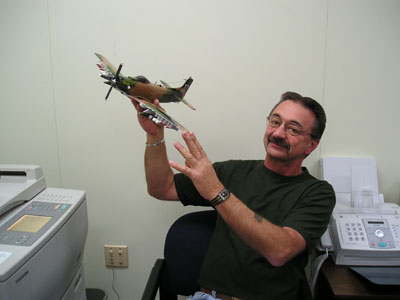By Janie Southard
jsouthard@dailystandard.com Seeing a howitzer shell as a graceful urn or three artillery shells as a Lockheed Lightning P-38 aircraft isn't difficult for trench art collectors like Tom Risch.

Risch, a Vietnam vet and now the service officer for Mercer County Veterans Service, began collecting trench art about two years ago and has since acquired enough pieces to fill a large glass showcase in his office.
Trench art, now highly collectible, was made from military items (usually spent ammunition) by soldiers and prisoners of war as souvenirs or made for soldiers by locals.
"Many of the airplanes are made from melted down artillery and then poured into mold," Risch of Celina says. "They were probably made by civilians who either sold or gave them to soldiers."
It was not unusual during World Wars I and II for local people to pick up spent shells or other items and from it create art, according to Risch. They then would trade for C-rations, cigarettes, etc. "But many items were made by the soldiers themselves during a lull in the action or behind the lines. Sometimes they'd send them home as love tokens to their mothers or sweethearts," Risch says while pointing to a P-38 made of three long shells with flattened brass forming the wings and tail.
One piece in the collection is hardly a love token; rather, Risch classifies it as G.I. humor. It's a 5-inch, sculpted caricature of Adolph Hitler made from melted bullets. The figure, in the sieg-heil posture, shows the familiar blunt mustache and the wayward forelock of hair over his eye.
There were a lot of crucifixes made in the trenches and they're now available at various Internet auction sites where Risch has purchased most of his collection. "They bring about $15 or so because there are so many. You know, a lot of guys got religion in a foxhole," Risch says.
Another war memento in Risch's collection is a Bakelite (an early plastic) model plane, from Great Britain, used to train Civil Defense volunteers to recognize different aircraft and determine if it was friendly or not.
All things concerning old military aircraft are a passion with Risch. His office features an abundance of airplane photos, clocks, propellers, a nose cone that has been signed by area Vietnam vets, and 35 model airplanes.
Hand-made in the Philippines, the models feature an 18-inch wingspan and are made of solid mahogany pieces fitted together. They are individually painted to duplicate the original plane.
Risch sent a photo of a special Skyraider A1-E he worked on in Vietnam. The Philippine artisans sent back an exact model. It's his favorite of the collection.
"These planes were originally made during World War II. It was used some in Korea, but it turned out to be the perfect plane for Vietnam. It could fly low and slow and was good for jungle fighting," explains Risch, an Air Force staff sergeant who served two of his four-year term in southeast Asia working on crash recovery.
He recalls the story of a particular pair of Skyraiders, one that crashed and one that didn't.
"Our pilots would fly sorties in pairs. (A sortie is a flight out and back.) As I said, the Skyraider was a real good jungle fighter and carried all kinds of power under the wings -- 20 mm cannons, bombs, rockets, napalm, etc.
"So two planes went out, spent all their armament and on the way back one was shot down by ground fire. The pilot ejected and landed somewhere in the jungle.
"The second pilot flew in circles around where his buddy had gone down. He was marking the spot until rescue could arrive. Then he saw Viet Cong on the ground and knew his buddy would be killed or captured.
"Remember, he was out of ammo. So he flew 'on the deck' (Air Force slang for very, very low flying) and flew through the enemy using the plane's propeller as a weapon to protect the downed pilot. He eliminated the enemy, but it's a wonder he didn't crash he was so low," Risch says shaking his head.
"The pilots were amazing people. They would continue to fly, coming in and switching to a refueled plane two and three times, until they either found their buddy or discovered he was lost to them."
The Skyraider Risch worked on had been hit with enemy fire over the jungle and had limped to the Plain of Jars in Laos, the destination pilots of damaged planes tried to get to for rescue. There the plane would be repaired or used for parts.
"I was all over these planes -- cockpits and inside the wings. We took saws into the jungle to cut up the crashed planes to get them out, because the Viet Cong would melt them down for ammunition.
"Oh, yeah, the Skyraiders were magnificent planes. I spent 367 days of my life working on them. I remember them well," he says as he gently holds the mahogany model from his collection. |

